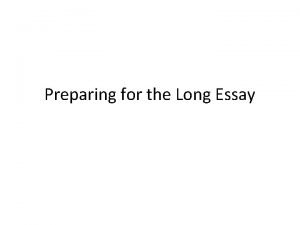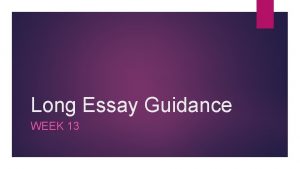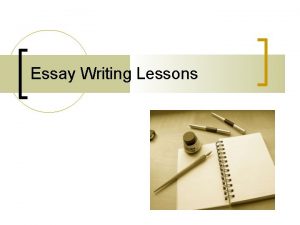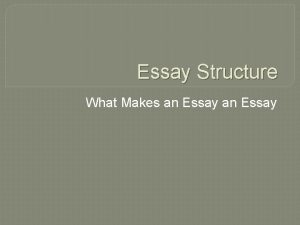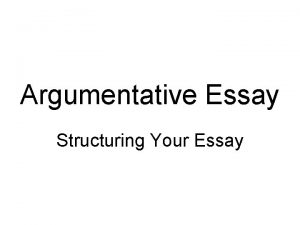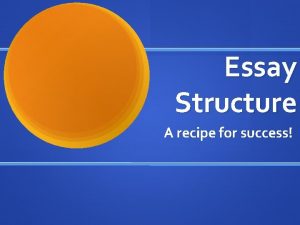FORMALIST ANALYSIS ESSAY Form Structure in A Long









- Slides: 9

FORMALIST ANALYSIS ESSAY Form & Structure in A Long Way Gone

Your Goals ■ Demonstrate understanding of formalist literary criticism. ■ Demonstrate close reading of Ishmael Beah’s memoir, A Long Way Gone. ■ Remain formal and objective in your tone: – Critique without insult. – Avoid author flattery.

Your task ■ Write a 750 -900 word essay ■ Examine one facet of formalism and focus on: – How the author uses the form/structure/device – What impact it has on the text ■ Example looking at question 10: From what point of view is the content of the text being told? – Beah uses first person narration… ■ ■ to invite his audience into the setting of the story, and to allow the audience to experience the events alongside him.

A SAMPLE INTRODUCTION Refer to the hand-out

Breaking down the example From the example: What is being done: ■ “Few of those who have the privilege of owning books…” ■ Starts with a brief summary: one synopsis of the story. ■ “For this reason, he immerses his audience into his home country in all its contrast…” ■ Leads into thesis by referring to the narration style as a “campfire tale”. ■ “Through the use of first person perspective, Ishmael Beah allows his audience to experience…” ■ “This point of view is only made more poignant by his tendency to remove himself from the situation…” ■ Uses open thesis: one sentence claim that details the facet of formalism and the overall intent. ■ One sentence methodology that shows how the claim will be “proven”.

From here, it’s familiar territory. ■ Construct multiple body paragraphs that support your thesis. ■ Use evidence from the text in each body paragraph. – Transition and lead in to your quotes using context. – Be sure to cite your quotes according to MLA guidelines. ■ Spend quality time in the analysis portion of each body paragraph: – What is the significance of the evidence you have provided in terms of its overall impact on the text? – What is the author’s intent in including this, and presenting it in this manner? – How does the evidence support your thesis? ■ End with a concluding paragraph that not only revisits your thesis, but also how and why this is significant.

Reminders: Formal Language ■ No first or second person—let the text and author speak for themselves. ■ Write out single and two-digit numbers. ■ Refer to the author once by his full name, then by his last name. You are not on a first-name basis with Ishmael Beah. ■ No rhetorical questions—do not talk to your audience. ■ Avoid unnecessary intensifiers (very, really, truly); pick strong verbs, clear nouns, and descriptive adjectives instead. ■ Write about literature in present tense.

FLIP OVER THE HANDOUT Let the rubric be your guide!

Goals for today: 1. Choose a facet of formalist analysis (juxtaposition, parallelism, symbolism, mood, allusion, etc. ). 2. Compile evidence associated with that facet (look back on double-entry journals for good information and evidence). 3. Arrive at a working thesis based on the evidence. 4. Begin organizing the evidence and analysis of your body paragraphs. Oftentimes, writers will save their strongest point for their final body paragraph.
 Tall + short h
Tall + short h Once upon a time there lived a boy
Once upon a time there lived a boy Structural/formalist approach
Structural/formalist approach Contracted form of we are
Contracted form of we are Restate thesis examples
Restate thesis examples Formalistic approach in literature
Formalistic approach in literature What is the difference between new criticism and formalism
What is the difference between new criticism and formalism Example of formalist
Example of formalist Advantages and disadvantages of literary criticism
Advantages and disadvantages of literary criticism Structuralist formalist meaning
Structuralist formalist meaning











